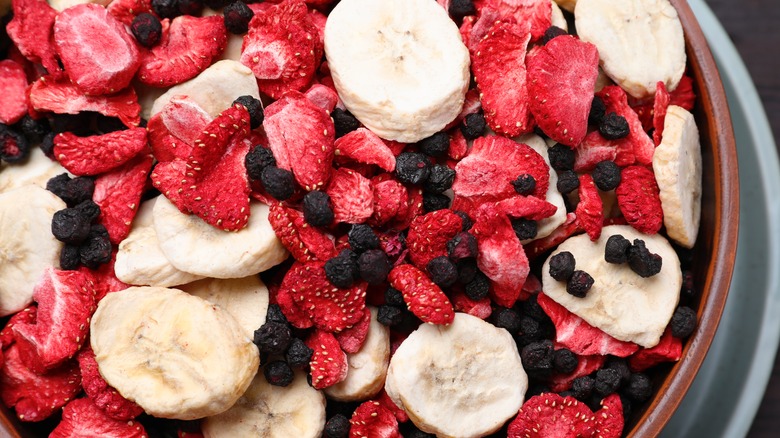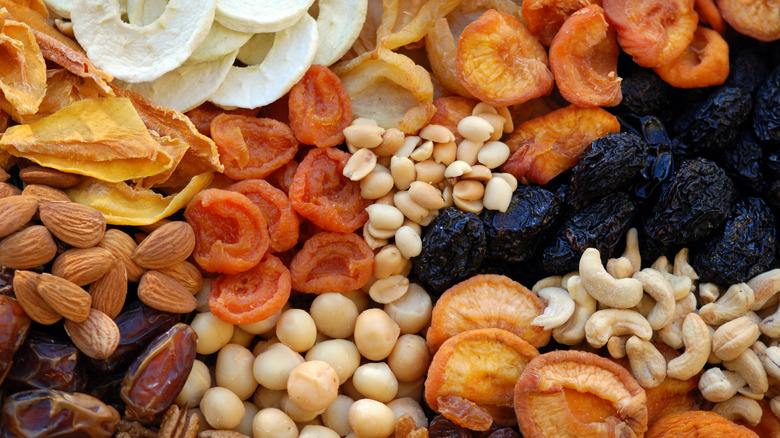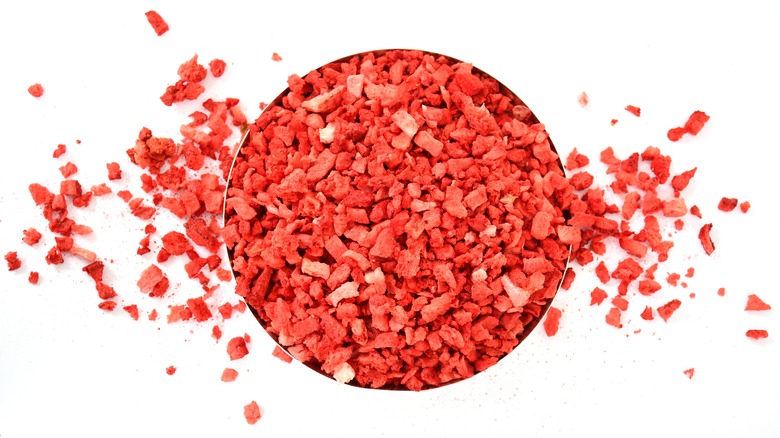Freeze-Dried Fruit Vs Dehydrated Fruit: What's The Difference?
Dehydrating food is an ancient method of preservation that still works wonders to this day. It extends the shelf life of fruit — one of nature's most nutritious offerings — by draining the majority of its moisture and preventing the accumulation of mold. The downsides are that dried fruit has a very different flavor and texture compared to its original state, and vital vitamins and minerals are drained during the dehydration process.
An alternative preservation method for fruit is freeze-drying. Freeze-dried fruit can be stored for nearly a decade, and uses a different process than dehydration to remove moisture. Although not dating back to prehistoric times like dehydration, freeze-drying is not a recent trend. Invented in 1906, freeze-dried foods increased in production in the 1950s with industrial freeze-dried food designed for longevity. By discovering new and innovative ways to dry food without stripping its nutrients, companies offered a much less wasteful alternative to storing food produce for households across the globe.
When it comes to food waste, fruit and vegetables have a relatively short shelf life compared to tinned products like beans, lentils, and legumes, as well as starch-heavy foods such as bread and nuts. It's important to take into account the similarities and differences when choosing between freeze-dried or dehydrated fruits.
Freeze-dried fruit and dehydrated fruit use different appliances
Whereas dehydrated fruit is dried in an oven, or a similar furnace-like appliance, freeze-dried fruit is prepared in commercial freeze dryers that drain the fruit of moisture. Frozen at sub-zero temperatures, the fruit is then dried with a vacuum pump, before it is finished in a processing chamber that removes almost all the remaining air and water vapor. The result is a completely dry product, suitable to store in room temperature shelves or cupboards.
Making dehydrated fruit is less complex. Freshly washed and ripe fruit is baked in an oven at approximately 200 degrees Fahrenheit for several hours (any hotter and the fruit will cook instead of dehydrate). If you don't have access to a dehydrator, that is. Or, fruit can be dehydrated at 145 degrees Fahrenheit for six to 18 hours in a dehydrator. The dried fruit is then stored in a dry, airtight container to preserve it. Although longevity varies depending on the fruit, most last for about a year as long as it's not subjected to any moisture. The flavor is also sacrificed during dehydration, as the fruit's texture is rendered more leathery.
Freeze-dried fruit can be stored for far longer — 25 to 30 years when stored correctly. The triple-tiered process used to strip away moisture is more effective and, unlike, dehydration, none of the taste is lost. However, dehydrating fruit is easier to do at home; all it takes is an oven.
What fruit can be freeze-dried or dehydrated?
Most fruit can be freeze-dried and stored for long periods thanks to their low fat content. This includes apples, mangos, bananas, pears, apricots, berries, citrus, pineapples, watermelon and dragonfruit. The same fruits can be dehydrated, in addition to plums, grapes, and cantaloupe.
Dried fruit makes a great addition to a range of cakes, ice cream, and pies. As well as adding a splash of color, freeze-dried fruit adds plenty of flavor but no moisture, making them ideal for baking. Freeze-dried fruit can also be used to make syrup; simply place the fruit in a small saucepan with equal amounts of water and sugar, then simmer, reduce, and strain. This fruity syrup is perfect for desserts and drinks and can be stored at room temperature in glass jars.
Dehydrated fruit can be consumed as it is, or rehydrated with moisture. By soaking dried fruit in cold water, then boiling and simmering for 15 minutes, it can be revived and ready to be used, adding a fruity flavor to a range of dishes.


